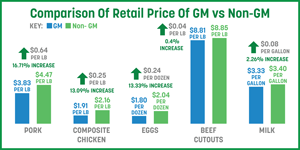
Written by: Lara Moody | April 5, 2022
 In recent years, an increasing number of foods are being marketed and labeled as free of genetically modified (GM) ingredients. For milk, meat or eggs, this means the animals these foods come from are fed exclusively non-GM feed. You need to look no further than current headlines to see the attention given to rising food prices, the need to curb greenhouse gas (GHG) emissions and other sustainability elements.
In recent years, an increasing number of foods are being marketed and labeled as free of genetically modified (GM) ingredients. For milk, meat or eggs, this means the animals these foods come from are fed exclusively non-GM feed. You need to look no further than current headlines to see the attention given to rising food prices, the need to curb greenhouse gas (GHG) emissions and other sustainability elements.
Though GM-crops have safely been used in food and feed for over 20 years, there is still interest in non-GM food stuffs. At the Institute for Feed Education and Research (IFEEDER), we spearheaded a research project that examined the impact of non-GM feed if production were to expand to meet the needs of the marketplace. Because of the potential impact on the U.S. food industry, it’s important to understand the implications of GM-free feed production.
In a recent report funded by the Institute for Feed Education and Research (IFEEDER), along with Dairy Management Inc., MFA Incorporated, the National Corn Growers Association, U.S. Poultry and Egg Association and other partners, researchers from Iowa State University and Decision Innovation Solutions explored the potential economic and environmental impacts that increasing GM-free feed production could have on farms, at grain elevators and in feed mills. Given the current U.S. adoption rate of GM seeds (over 92% for both corn and soybeans) and the on-farm benefits of GM traits (from reduced labor and fuel use to improved crop yields and soil health), a significant premium would be required to entice a farm’s return to non-GM seeds.
The researchers quantified increased land conversion, nutrient loss and GHG emissions primarily linked to the yield advantage offered by GM seeds. For example, with corn, GM seed yields can be up to 25% greater compared to non-GM seed from near isogenic lines containing similar genetic makeup.
Solely based on increased fuel combustion, a 5% increase in non-GM corn acres would increase GHG emissions by 7% annually.
 As the animal production sector pursues ambitious sustainability targets, feed implications are a key consideration. The scope of GHG emissions and other elements linked to GM vs. non-GM feed must be considered as carbon footprints and lifecycle analyses are used to map a path to evolving sustainability targets.
As the animal production sector pursues ambitious sustainability targets, feed implications are a key consideration. The scope of GHG emissions and other elements linked to GM vs. non-GM feed must be considered as carbon footprints and lifecycle analyses are used to map a path to evolving sustainability targets.
The researchers also evaluated the costs and feasibility of achieving segregation requirements for handling GM vs. non-GM seed in U.S. grain and feed systems. What is probably most interesting for American Feed Industry Association (AFIA) members is that for feed production, the ability to be part of a potentially expanding GM-free feed market has capital and operating cost considerations.
.png)
And, the ability to segregate to achieved desired adventitious presence (AP) tolerance levels is feasible, but the management requirements add a higher level of complexity unless the facility is solely dedicated to non-GM feed.
For a single processing line feed mill, tolerances equivalent to the mean impurity of the incoming ingredients could be achieved with temporal segregation. So, if the incoming material had 0.9% AP, that could be maintained. To ensure low impurity of incoming material, validate sampling and testing methods are needed. For feed mills with multiple processing lines, a judicious combination of robust segregation strategies beginning with receiving of raw materials is necessary to achieve 0.9% tolerance.
 Not only does segregating non-GM feed from GM feed pose challenges for feed mill managers, but it also adds to the costs, with the research showing it could increase the price of feed by as much as $4 to $9 per ton of pork, layer and broiler feed, by 40 cents to $3 for beef feed and $1 to $4 for dairy feed. This, in turn, has implications for consumers, as food prices could potentially increase by as much as 16% per pound of meat.
Not only does segregating non-GM feed from GM feed pose challenges for feed mill managers, but it also adds to the costs, with the research showing it could increase the price of feed by as much as $4 to $9 per ton of pork, layer and broiler feed, by 40 cents to $3 for beef feed and $1 to $4 for dairy feed. This, in turn, has implications for consumers, as food prices could potentially increase by as much as 16% per pound of meat.
I invite you to read the high-level summary of the report and review the full report on IFEEDER’s website. As a feed industry, awareness of the implications of increasing GM-free feed production can help in our own decision making. However, it’s also important that research like the work IFEEDER is pursuing can help inform the decisions of our customers, and their customers as well.
Comments See our policy on comments